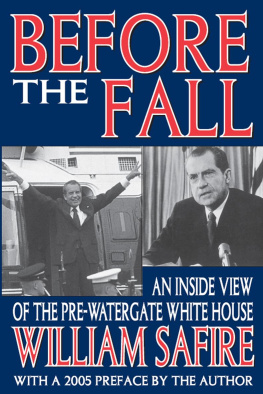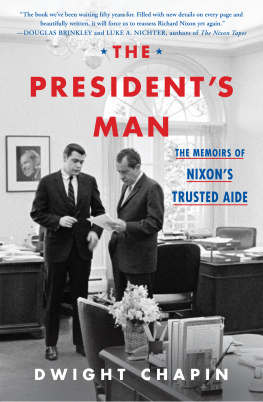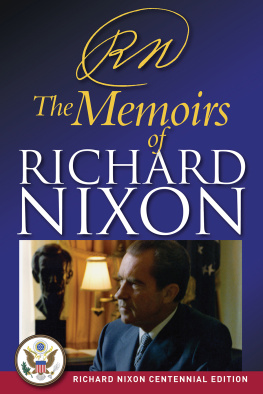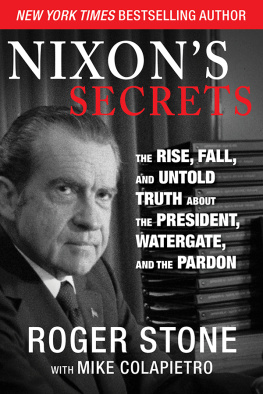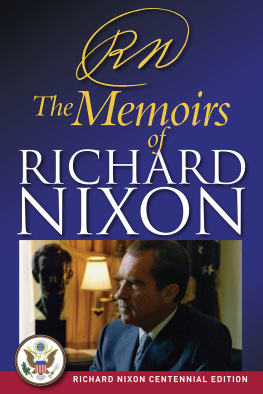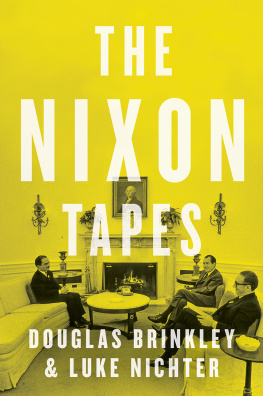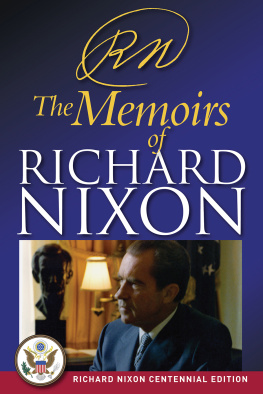Ray Lockers latest book is a bombshell! It will force us to consider what we thought we knew about the final year of Richard Nixons presidency and the role of Alexander Haig. Even Watergate aficionados will learn plentyand yearn for more.
Luke A. Nichter, author of The Nixon Tapes: 1973
Ray Locker has done extraordinary work here: Haigs Coup is a deep dig that will force a major reset of the perceived history of the Watergate era. Im honored to have had an early peek at it. I learned a lot.
Ed Gray, coauthor of In Nixons Web: A Year in the Crosshairs of Watergate
Ray Locker is a probing newsman, an indefatigable researcher, and a talented historian. His return to the subject matter of the Nixon White House is good news to all students of the modern presidency, for there is no one better equipped to mine the remaining secrets of that tumultuous era. The truth is out there, and Ray Locker is the man to get it.
James Rosen, former Fox News chief Washington correspondent and author of The Strong Man: John Mitchell and the Secrets of Watergate

Haigs Coup
How Richard Nixons Closest Aide Forced Him from Office
Ray Locker
Potomac Books | An imprint of the University of Nebraska Press
2019 by Ray Locker
Potomac Books is an imprint of the University of Nebraska Press.
Cover designed by University of Nebraska Press; cover photo is courtesy of the Richard Nixon Presidential Library and Museum.
Author photo by Maggie Locker.
Frontispiece courtesy of the Richard Nixon Presidential Library and Museum.
All rights reserved.
Library of Congress Cataloging-in-Publication Data
Names: Locker, Ray, author.
Title: Haigs coup: how Richard Nixons closest aide forced him from office / Ray Locker.
Description: Lincoln, NE : Potomac Books, an imprint of the University of Nebraska Press, [2019] | Includes bibliographical references and index.
Identifiers: LCCN 2018046952
ISBN 9781640120358 (cloth: alk. paper)
ISBN 9781640121782 (epub)
ISBN 9781640121799 (mobi)
ISBN 9781640121805 (pdf)
Subjects: LCSH : Nixon, Richard M. (Richard Milhous), 19131994Resignation from office. | Haig, Alexander Meigs, 19242010. | PresidentsUnited StatesStaffBiography. | GeneralsUnited StatesBiography. | Watergate Affair, 19721974. | Nixon, Richard M. (Richard Milhous), 19131994Impeachment. | Executive powerUnited StatesHistory20th century. | Civil-military relationsUnited StatesHistory20th century. | United StatesPolitics and government19691974.
Classification: LCC E 861 . L 63 2019
DDC 973.924092/2dc23 LC record available at https://lccn.loc.gov/2018046952.
The publisher does not have any control over and does not assume any responsibility for author or third-party websites or their content.
To Shirley
Contents
The act of writing may be solitary, but writing a book depends on collaboration, and it took a dedicated group of collaborators to make Haigs Coup a reality. That group starts with Len Colodny. For more than twenty-five years he has been an advisor, an inspiration, and a trusted friend. No one has keener insights into the world of Richard Nixon and Alexander Haig, and no one has fought the keepers of the conventional wisdom longer and more successfully than Len has. His wife, Sandy, son, John, and daughter, Sherry, fight the good fight with him and are turning Lens work into an enduring gift with the Colodny Collection at Texas A&M University.
Shirley Higuchi gave me the confidence and support to write this book in a calm and friendly environment. I am forever grateful for her love, kindness, and generosity in helping make the book a reality. Her introduction to the Rancho La Puerta in Tecate, Mexico, provided a refuge for writing and reflection.
My daughters, Maggie Locker-Polding and Abbey Locker, were, as always, great sounding boards and supporters, forever patient in their knowledge that sometimes Dad gets distracted and thinks about old figures in history a little too often.
Luke Nichter of Texas A&M University is one of the leading Nixon scholars and a great researcher. He has supplied me with documents from his vast trove, including those about FBI official William Sullivan, Department of Justice official Robert Mardian, reporter Bob Woodward, and Alexander Haig.
Ed Gray, author and son of former acting FBI director L. Patrick Gray, provided years of research materials and encouragement. He was the first to mine the Woodward and Bernstein Watergate Papers at the Harry Ransom Center at the University of Texas at Austin and expose the numerous inconsistencies between their notes and books. His insights led me to dig further into the life and work of William Sullivan, which yielded many of the new details here. He helped make this book what it is today.
Authors, officials, scholars, and advisors essential to the existence of Haigs Coup include Robert Gettlin, who put his heart and soul into the book he wrote with Len Colodny, Silent Coup: The Removal of a President; James Rosen; John A. Farrell; Brian Robertson; Evan Thomas; Joseph Califano; Martin Lobel; and Fred Graboske.
The resources at the Harry Ransom Center at the University of Texas; the Harold Weisberg Collection at Hood College in Frederick, Maryland; the Lowell Weicker Papers at the University of Virginia; the Richard Nixon Presidential Library and Museum in Yorba Linda, California; the Gerald R. Ford Presidential Library and Museum in Ann Arbor, Michigan; the LBJ Presidential Library in Austin, Texas; the Defense Department; the FBI ; the CIA ; and the State Department Office of the Historian were incredible aids. No historian writing about postwar America should be without them.
Friends and colleagues provided incredible support and insistence. Much of the inspiration came from more than thirty years of conversations with Lee Landenberger, whose fascination with the events of the Nixon era kept me going. There is no better friend. Michael Fechter helped expose the flaws in earlier collections of White House tapes and provided critical help with all stages of the manuscript. Margaret Talev, as always, provided her keen insights and encouragement. Peter Viles, Mike Casey, Fredreka Schouten, Tom Vanden Brook, Chrissy Terrell, David Jackson, Gregory Korte, David Callaway, Lee Horwich, Susan Page, Julie Mason, and Cooper Allen provided personal and professional assists along the way. Special thanks to Kelly Kennedy for helping to line up my agent, the incredible Scott Miller of Trident Media.
Any long project depends on the help and patience of family. My parents, Bob and Marge Locker, who voted for Richard Nixon for president three times, provided tremendous support and encouragement. They are everything anyone would want in parents. Alan Polding, my son-in-law, weighed in with his perspectives as a citizen of the United Kingdom watching current events in the United States. Finally, to the rest of my extended familyLauren, David, Julia, and Henry Piper and Marina and Steven Sweeney; Lydia, Steve, Ian, and Paul Josowitz; Debbie and Richard Etchison; Bill, Angie, and Amelia Collier and Adele Collierthanks for the kind thoughts and help.
I Am in Control Here
Emotional and breathless, Alexander Haig faced an anxious press corps and nation in the White House briefing room at 4:14 p.m. on March 30, 1981, to announce who led the nation as President Ronald Reagan lay anesthetized in an operating room at George Washington University Hospital. Haig had scrambled from the State Department to the White House to manage the crisis caused by the assassination attempt on the new president. Reagan, it seemed, would survive, but a nervous, jittery nation that had seen a president killed and another forced out of office in the previous twenty years needed to know someone was capable of making decisions in the White House.
Next page

